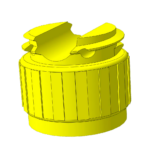Plastic or wood ?!
The European Anti-Plastic Law
Often, a person tasked with solving a problem unwittingly creates a new one. He starts to solve the second problem, because the first does not seem significant to him. That’s all! Thus, the circle is closed, everything is messed up… Is it a familiar situation? But, generally, the solution in such cases is simple and does not require grandiose ideas and huge investments.
Can you imagine that even such aproblem as planet pollution is no exception? In this case, everything follows the same pattern. One day they began to introduce plastic products everywhere supposedly to save trees from being chopped down. Some time passed, a lot of plastic waste was generated, and in panic people decided to cut down trees again. Thus, it was decided to make disposable paper dishes and stirring sticks again!
The modern world is arranged in such way that, whether we want it or not, enterprises will produce a huge amount of materials, which immediately become unnecessary as soon as they reach their consumer. As packaging or containers, for example: any product we buy, whether in a supermarket or on a market, requires packaging. Previously, paper packaging was more popular, but gradually plastic began to be introduced. Nowadays, plastic surrounds us everywhere, but is that so bad? Paper packaging is, of course, more eco friendly, but how many trees die so that we can buy a carton of milk or get a pie wrapped up in a paper bag in a cafe?! Such paper is not recycled unlike plastic. In addition, paper production is quite expensive for enterprises, because the cellulose production process is quite complicated. Plastic production, on the other hand, is cheap, and it can be recycled numerous times. It’s only important to learn how to do it properly. If people had been puzzled about solving this issue before, now we would not have had to deal with the consequences. Simple? I’m sure you’ll agree, “Yes!”
However, time has passed and the problem still exists. Now it is important to make a decision as soon as possible… Have you heard that the Pacific Rubbish Island has reached an incredible size? One of the main reasons behind this was the mass use of disposable plastic dishes without subsequent processing. Why did this happen? We can only assume. Perhaps it is all to do with a huge number of positive qualities and advantages of this material on the one hand which allowed it to become a mass, but on the other hand, its low cost which makes it difficult to establish the process of its disposal.
Let’s list some pros and cons below:
So, what’s good about plastic?
1.The use of plastic reduces deforestation, besides, cellulose production is not such an eco-friendly process.
2.Most plastic can be recycled many times, in the same way as aluminium and glass containers too.
3.Plastic is characterised by its high mechanical strength and wear resistance.
4.Plastic is elastic, which makes it possible to manufacture articles and details of the most complex shapes, and with minimal time and forces, for example, by the plastic injection method.
5.Plastic products can be produced in almost any texture and colour.


